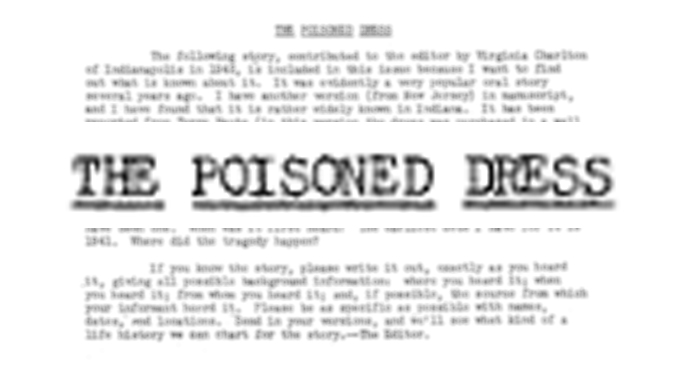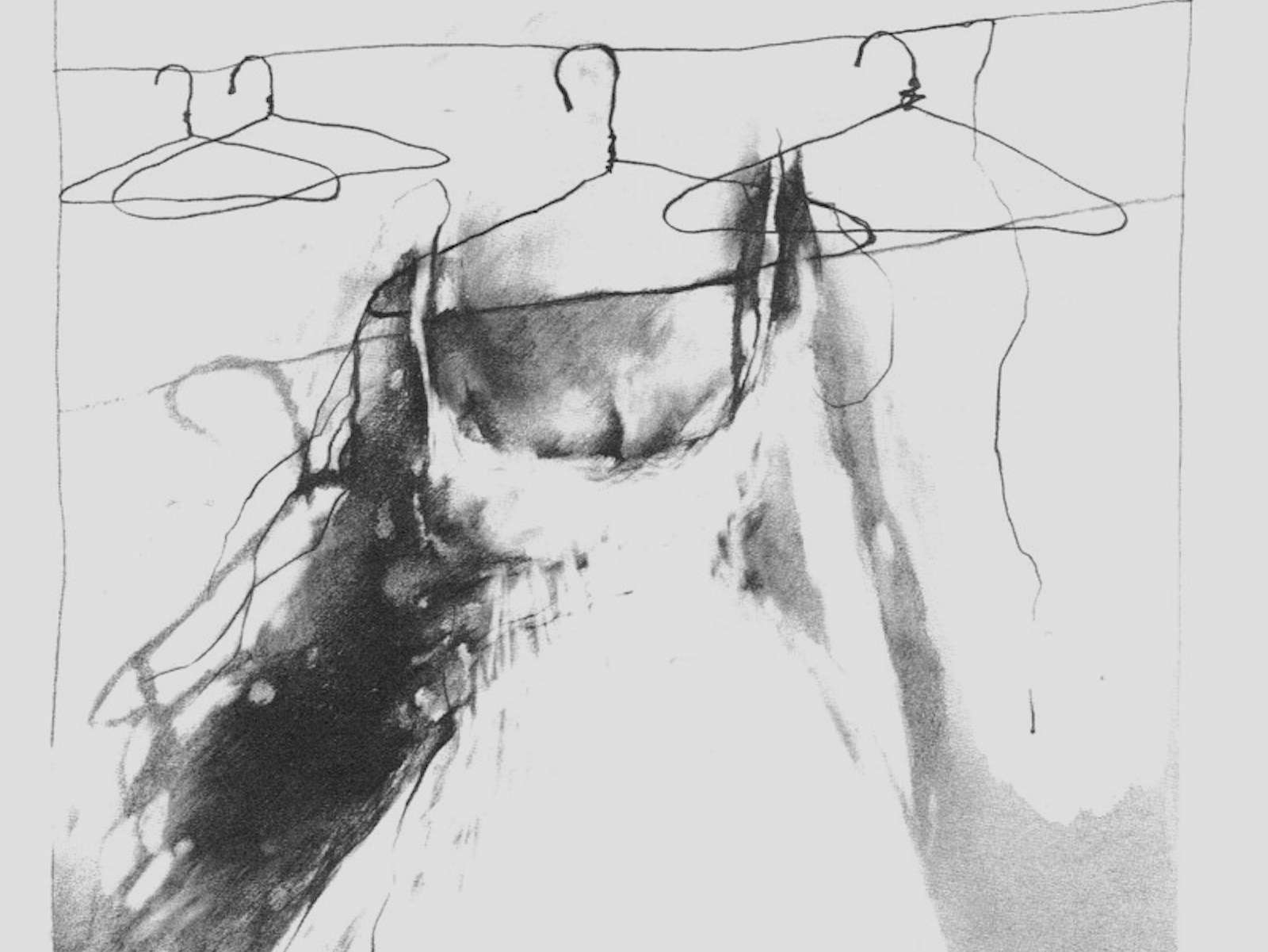I made a documentary about Scary Stories to Tell in the Dark. (Now available to watch.) The three books consisted of over 80 stories of folklore and urban legends. It was impossible to appropriately address each and every story in a single documentary. This website, in part, is a chance to look at individual stories that I researched, tales in which I learned about their origins and social contexts. It’s a chance to examine stories that I ultimately found to be fascinating in some way or another.
This is The White Satin Evening Gown.
The story of a formal dance and an unlucky young lady, featured in Scary Stories to Tell in the Dark, is one of the relatively simple tales that truly is influenced by the build up and how well you describe what takes place. Told well, it can be quite disgusting… and memorable.
The Tale of the White Satin Evening Gown
Here is how it appeared in Alvin Schwart’s Scary Stories to Tell in the Dark, originally published in 1981.
A young man invited a young woman to a formal dance. But she was very poor, and she could not afford to buy the evening gown she needed for such an occasion.
“Maybe you can rent a dress,” her mother said. So she went to a pawnshop not far from where she lived. There she found a white satin evening gown in her size. She looked lovely in it, and she was able to rent it for very little. When she arrived at the dance with her friend, she was so attractive, everyone wanted to meet her. She danced again and again and was having a wonderful time. But then she began to feel dizzy and faint, and she asked her friend to take her home.
“I think I have danced too much,” she told him. When she got home, she lay down on her bed. The next morning her mother found that her daughter had died. The doctor did not understand what had caused her death. So he had the coroner perform an autopsy. The coroner found that she had been poisoned by embalming fluid. It had stopped her blood from flowing. There were traces of the fluid on her dress. He decided it had entered her skin when she perspired while she was dancing.
The pawnbroker said he bought the dress from an undertaker’s helper. It had been used in a funeral for another young woman, and the helper had stolen it just before she was buried.
The Origins of the Tale
As many remember, Alvin Schwartz expanded in the back matter of the books where the story came from. Or at least, where he got it.
From those notes we have the story of “The Poisoned Dress,” as described by Herbert Halpert. Which mostly mimics the story we have in Scary Stories to Tell in the Dark. The story from Herbert Halpert was placed next to such other folk tales as “The Well-Trained Hunting Dog” and “The Ineradicable Blood Stain.” And it is like many such journals of folk tales. Scrolled in typewritten letters. From the point of view of a folklorist, recording the tale for posterity rather than overtly trying to scare an audience.

Like many other tales in the books, Alvin Schwartz rewrote the story for his purposes. Like any folk tale or urban legend, the choices made reflect the author and the audience. For the books, the audience was kids, repackaged as a collection of scary stories that by the early 1980s publishers were beginning to understand they wanted for reading material. It was at the back of the books that he fit in commentary and source material, where in journals such as the Hoosier Folklore Bulletin it was part of the telling… the audience was other folklorists, researchers, other adult storytellers of different kinds. For Alvin Schwartz the details about the story were fascinating, but he knew that it made sense for the back in this format, it was for those kids who had the interest in finding out more.
What’s fascinating about this story is that it is indicative of folklore in general, and that is, that origins are fascinating when they are found, but also intriguing when they often aren’t. In this case, we have a man named Herbert Halpert and his interests in this tale. His desire to find the origin.
“The following story, contributed to the editor by Virginia Charlton of Indianapolis in 1942, is included in this issue because I want to find out what is known about it. It was evidently a very popular oral story several years ago.” He cites that other similar versions of the tale he has found in New Jersey and elsewhere.
When was it first heard? The earliest date I have for it is 1941. Where did the tragedy happen?
From my records (which I admit I couldn’t realistically do an exhaustive search for each and every story), that is where it left off. One man interested in this urban legend, wanting to know if there is a single source for it. But then it ends. Or at least, any follow-up information may likely be lost in time.
Perhaps one could find an example of someone in the news who died under somewhat similar circumstances. But my experience is that a vast majority of the time, it isn’t that simple. In this case, there doesn’t seem to be an obvious case that links this story to one instance. (If someone finds it, please, let me know. I’ll add it to this article.)
Even if you found a similar case, the world is large and people die all the time. Linking this story to a specific case is often dubious. Urban legends take shape from multiple things all gelling and morphing over time. By the time they are written down by someone like Herbert Halpert, they are an amalgamation of fiction, imagination, and a sliver of truth. Which I find interesting. But also, it doesn’t lend itself to the origin story that many people want. People often grow up on mystery novels and want that mystery tale to be wrapped up in a nice conclusive A then B then C plot line. If you’re looking for that, I don’t think folk tales and urban legends are the best place to be searching after that.
The story is more often one like of Herbert Halpert. Kindly searching for an origin, reaching out for answers. And at best, getting partial truths.
Finding Meaning in the White Satin Evening Gown
The tales we tell, especially the ones that have resonance in our culture, tend to tell something about ourselves. This story is no different.
In this case, the central item is introduced as something for poor people. A second-hand dress for those who cannot afford to purchase new clothing. And there, you have a theme that I did find often from one folktale to another. And that is, a fear of what the poor and foreign people tend to do when they cannot conform to what is considered “clean” or socially acceptable.
In “Sam’s New Pet” or the tale of the Mexican hairless, you have an obvious fear of foreigners and the weird pets you may bring back from their lands. In “Wonderful Sausage” and its variants you have a fear of poor people and the food they may cook up and serve you. And so in “The White Satin Evening Gown” there is a sense that the dirty second-hand clothes that poor people wear, especially when they are trying to look nicer and not so poor, inevitably has a stench underneath that cannot be washed off.
— FOUNDATIONS OF HORROR —
Further explore these subgenres & tropes. more>>
#Scary Stories to Tell in the Dark | #Folk horror | #Sex and gender horror

I’m not saying we can’t appreciate the scary stories found in these wonderful books. But time and again, like the Grimm’s tales and the twisted cultural underpinnings of many of them, it’s also important to acknowledge that there are unseemly and often hateful connotations found in the scary tales we tell ourselves.
We can also find more fascinating things in the story, ones that don’t seem so controversial but are interesting nonetheless.
It can be helpful to look at differences between versions to find meaning. A change that Alvin Schwartz made was this. In Halpert’s version “her escort” took her home and described an “odor” to a doctor, ultimately learning about the poisoning.

In Alvin Schwartz’s version, it was changed to her mother who made the discovery.
I think it is notable in the same way that “The Red Spot” is. In fact, the two stories are quite similar. And in both, Schwartz chooses to make the central characters the young lady and her mother, versus other options, which is to have the story involve a girl and her “escort” in some way. Like any folk tale or urban legend, there is no one definitive version. That’s what makes them folk tales.
Both “The White Satin Evening Gown” and “The Red Spot” involve young women and a certain interest in looking attractive in public. And both involve mothers who in some way are not able to provide for them… either by not purchasing a new, nice dress or not diagnosing a “pimple” in a way that ultimately helped. Both scary stories in some small way touch on the failures of mothers and their abilities to prepare their daughters for the horrors of the world.
Last Updated on April 12, 2021.

